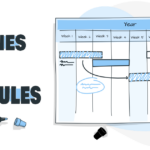Market research and competitive analysis are crucial steps in the process of starting a business. They help entrepreneurs understand their target market, identify their competitors, and make informed decisions about their business strategy. By conducting market research and competitive analysis, entrepreneurs can gain a deeper understanding of the industry, the market, and the customers they are trying to reach. In this article, we will discuss the role of market research and competitive analysis in starting a business and how entrepreneurs can use this information to create a successful business strategy.
Understanding the importance of market research and competitive analysis in the business development process
Market research and competitive analysis are essential steps in the business development process. They help entrepreneurs understand their target market, identify their competitors, and make informed decisions about their business strategy. In this article, we will discuss the importance of market research and competitive analysis and how entrepreneurs can use this information to create a successful business strategy.
- Understand your target market: Market research allows entrepreneurs to gain a deep understanding of their target market, including their needs, wants, and purchasing habits. This information is crucial for creating a product or service that meets the needs of the target market.
- Identify your competitors: Competitive analysis helps entrepreneurs understand their competition, including their strengths and weaknesses. This information is crucial for creating a unique selling proposition and differentiating the business from its competitors.
- Make informed decisions: Market research and competitive analysis provide entrepreneurs with the information they need to make informed decisions about their business strategy. For example, entrepreneurs can use this information to decide on the best pricing strategy, marketing tactics, and distribution channels.
- Monitor industry trends: Market research and competitive analysis also allow entrepreneurs to monitor industry trends and identify opportunities for growth. By staying informed about industry trends, entrepreneurs can take advantage of new opportunities and stay ahead of the competition.
- Develop a marketing strategy: Market research and competitive analysis provide insights into the target market, the competition, and the industry that can be used to develop a marketing strategy that effectively reaches and resonates with the target market.
- Continuously improve: Market research and competitive analysis are ongoing processes that entrepreneurs should continuously conduct to stay informed about changes in the market and the industry. This allows entrepreneurs to make adjustments to their business strategy as needed and stay competitive.
In conclusion, market research and competitive analysis are essential steps in the business development process. They help entrepreneurs understand their target market, identify their competitors, and make informed decisions about their business strategy. Entrepreneurs should conduct market research and competitive analysis regularly and use the information to create a successful business strategy and continuously improve the business.
Techniques for conducting market research and gathering customer feedback
Conducting market research and gathering customer feedback are essential techniques for understanding the needs and wants of your target market and making informed decisions about your business strategy. In this article, we will discuss different techniques for conducting market research and gathering customer feedback.
- Surveys: Surveys are a useful tool for gathering information about your target market. They can be conducted online, by phone, or in-person, and can include questions about demographics, purchasing habits, and opinions about your product or service.
- Focus groups: Focus groups are a method of gathering qualitative data by bringing together a small group of people to discuss a specific topic. They can provide valuable insights into consumer attitudes and behaviors, and can be used to test new product concepts and gather feedback on existing products.
- Interviews: Personal interviews are another way to gather qualitative data. These can be conducted in-person or over the phone and can be used to gather detailed information about a specific topic or to gather feedback on a particular product or service.
- Online research: Online research is a cost-effective way to gather information about your target market. Entrepreneurs can use online tools such as Google Analytics, social media analytics, and online surveys to gather information about their target market.
- Customer feedback: Customer feedback can be gathered through various methods such as surveys, focus groups, interviews, or online platforms. It’s important to actively seek feedback and respond to it in a timely manner to improve the product or service and retain customers.
- User testing: User testing is a technique used to gather feedback on a product or service from a group of users. This can be done through online tools, in-person sessions or through remote user testing. It provides valuable information about how the product is being used and helps to identify areas for improvement.
In conclusion, conducting market research and gathering customer feedback are essential techniques for understanding the needs and wants of your target market and making informed decisions about your business strategy. Entrepreneurs should use a combination of these techniques to gather a diverse range of information and get a comprehensive understanding of their target market.
How to identify and analyze your target market and customer demographics
Identifying and analyzing your target market and customer demographics is a crucial step in the process of starting a business. It allows entrepreneurs to understand the needs and wants of their customers and make informed decisions about their business strategy. In this article, we will discuss how entrepreneurs can identify and analyze their target market and customer demographics.
- Define your target market: The first step in identifying your target market is to define the characteristics of your ideal customer. This can include demographics such as age, gender, income, and education level, as well as psychographics such as values, lifestyle, and interests.
- Conduct market research: Conducting market research is an essential step in identifying and analyzing your target market. Entrepreneurs can use surveys, focus groups, interviews, and online research to gather information about their target market.
- Analyze your data: Once you have gathered data on your target market, you need to analyze it to identify patterns and trends. Look for information such as what products or services your target market is interested in, what problems they have, and what motivates them to make a purchase.
- Create customer personas: Creating customer personas is a useful tool for understanding your target market. A customer persona is a fictional representation of your ideal customer, based on the data you have collected. It can help you understand your target market on a deeper level and make informed decisions about your business strategy.
- Use customer demographics: Customer demographics are the characteristics of a customer, such as age, gender, income, and education level. These characteristics can be used to segment your target market and create targeted marketing campaigns.
- Keep track of changes: The market and customer demographics are constantly changing, so it’s important to keep track of these changes and adjust your business strategy accordingly. Entrepreneurs should conduct market research regularly to stay informed about changes in the market and the customer demographics.
In conclusion, identifying and analyzing your target market and customer demographics is a crucial step in the process of starting a business. Entrepreneurs should conduct market research, analyze data, create customer personas, and use customer demographics to make informed decisions about their business strategy. It’s also important to keep track of changes in the market and customer demographics and adjust the business strategy accordingly.
The importance of understanding your competitors and their strengths and weaknesses
Understanding your competitors and their strengths and weaknesses is a crucial step in the process of starting a business. It allows entrepreneurs to identify opportunities for differentiation and make informed decisions about their business strategy. In this article, we will discuss the importance of understanding your competitors and how to analyze their strengths and weaknesses.
- Identify your competitors: The first step in understanding your competitors is to identify who they are. This includes direct competitors, who offer similar products or services, as well as indirect competitors, who offer substitute products or services.
- Gather information: Once you have identified your competitors, you need to gather information about them. This can include information such as their products or services, pricing, marketing strategies, and customer base. This information can be gathered through online research, industry reports, and customer feedback.
- Analyze their strengths and weaknesses: Once you have gathered information about your competitors, you need to analyze it to identify their strengths and weaknesses. Look for information such as what they do well and what they could improve upon.
- Identify opportunities for differentiation: By understanding your competitors’ strengths and weaknesses, you can identify opportunities for differentiation. This can include offering a unique product or service, targeting a niche market, or differentiating on price or customer service.
- Keep track of changes: The competitive landscape is constantly changing, so it’s important to keep track of changes in the market and your competitors’ strategies. Entrepreneurs should conduct competitor analysis regularly to stay informed about changes in the market and the competition.
- Use the information to improve your strategy: Understanding your competitors and their strengths and weaknesses can help you to improve your own business strategy. You can use the information to make changes to your products, services, pricing, or marketing to better compete in the market.
In conclusion, understanding your competitors and their strengths and weaknesses is a crucial step in the process of starting a business. Entrepreneurs should identify their competitors, gather information, analyze their strengths and weaknesses, and use this information to identify opportunities for differentiation and improve their own business strategy. Additionally, it’s important to keep track of changes in the market and the competition and adjust the strategy accordingly.
Tips for using online tools and resources for market research and competitive analysis
Online tools and resources can be extremely useful for conducting market research and competitive analysis. They provide entrepreneurs with access to a wealth of information and can save time and resources. In this article, we will discuss tips for using online tools and resources for market research and competitive analysis.
- Use Google Trends: Google Trends is a free tool that allows entrepreneurs to see how often a particular search term is entered into Google. This can provide insights into consumer interest in a particular product or service.
- Use social media analytics: Social media platforms such as Facebook, Twitter, and Instagram provide entrepreneurs with access to analytics on their audience and competitors. Entrepreneurs can use this information to understand their target market and identify opportunities for differentiation.
- Use online surveys: Online survey tools such as SurveyMonkey and Google Forms allow entrepreneurs to conduct surveys and gather information about their target market. These tools can be used to gather information about customer demographics, purchasing habits, and opinions about a product or service.
- Use competitor analysis tools: Online tools such as SEMrush and Alexa provide entrepreneurs with information about their competitors, including their search engine rankings, traffic, and advertising strategies.
- Use customer feedback tools: Online platforms such as UserTesting and Qualtrics provide entrepreneurs with a way to gather customer feedback on a product or service. This feedback can be used to improve the product or service and increase customer satisfaction.
- Use online marketplaces: Online marketplaces such as Amazon and Alibaba provide entrepreneurs with access to information on consumer trends and industry insights. Entrepreneurs can use this information to identify new opportunities and stay informed about changes in the market.
In conclusion, online tools and resources can be extremely useful for conducting market research and competitive analysis. Entrepreneurs should use a combination of these tools to gather a diverse range of information and get a comprehensive understanding of their target market and competition. Additionally, it’s important to keep track of changes in the market and adjust the research and analysis accordingly.
Strategies for conducting a SWOT analysis to evaluate your business’s strengths, weaknesses, opportunities, and threats
A SWOT analysis is a useful tool for evaluating a business’s strengths, weaknesses, opportunities, and threats. It allows entrepreneurs to identify areas for improvement and make informed decisions about their business strategy. In this article, we will discuss strategies for conducting a SWOT analysis to evaluate your business’s strengths, weaknesses, opportunities, and threats.
- Define the scope of the analysis: The first step in conducting a SWOT analysis is to define the scope of the analysis. This includes identifying the specific aspects of the business that you want to evaluate, such as the products, services, market, or competition.
- Gather information: Once you have defined the scope of the analysis, you need to gather information on the business’s strengths, weaknesses, opportunities, and threats. This information can be gathered through internal and external sources, such as customer feedback, industry reports, and competitor analysis.
- Identify strengths and weaknesses: Identify the strengths and weaknesses of your business by evaluating internal factors such as resources, capabilities, and processes. Identifying these can help you to understand where your business excels and where it needs to improve.
- Identify opportunities and threats: Identify the opportunities and threats of your business by evaluating external factors such as market trends, competition, and economic conditions. Identifying these can help you to understand the external factors that can positively or negatively impact your business.
- Use the information to develop strategies: Once you have identified your business’s strengths, weaknesses, opportunities, and threats, you can use this information to develop strategies for improvement. For example, if you identify a weakness, you can develop a plan to address it. If you identify an opportunity, you can develop a plan to capitalize on it.
- Keep track of changes: The business environment is constantly changing, so it’s important to keep track of changes in the market and re-evaluate your SWOT analysis regularly. Entrepreneurs should conduct a SWOT analysis regularly to stay informed about changes in the market and the competition.
In conclusion, a SWOT analysis is a useful tool for evaluating a business’s strengths, weaknesses, opportunities, and threats. Entrepreneurs should conduct a SWOT analysis regularly to stay informed about changes in the market and the competition. By identifying the strengths and weaknesses, opportunities and threats of a business, entrepreneurs can develop strategies for improvement and capitalize on new opportunities. Additionally, it’s important to re-evaluate your SWOT analysis regularly as the business environment is constantly changing.
How to use primary research methods like surveys, interviews, and focus groups
Primary research methods like surveys, interviews, and focus groups are an important tool for entrepreneurs to gather information about their target market and competition. These methods allow entrepreneurs to gather firsthand information and gain a deeper understanding of their customers and the industry. In this article, we will discuss how to use primary research methods like surveys, interviews, and focus groups.
- Surveys: Surveys are a popular method for collecting information from a large number of people. Surveys can be conducted online or through mail and phone. They can be used to gather information about customer demographics, purchasing habits, and opinions about a product or service.
- Interviews: Interviews are a method for gathering information from a small number of people. Interviews can be conducted in person, by phone, or online. They can be used to gather information about customer demographics, purchasing habits, and opinions about a product or service.
- Focus groups: Focus groups are a method for gathering information from a small number of people in a group setting. Focus groups can be used to gather information about customer demographics, purchasing habits, and opinions about a product or service.
- Identify the research questions: Before conducting primary research, it’s important to identify the research questions. This will help to guide the research and ensure that relevant information is gathered.
- Plan the research: Once the research questions have been identified, it’s important to plan the research. This includes deciding on the research methods, identifying the sample group, and creating a research schedule.
- Analyze the data: After the primary research has been conducted, it’s important to analyze the data to identify patterns and insights. This can be done using statistical analysis or qualitative analysis.
- Use the information to improve your strategy: The information gathered from primary research can be used to improve your business strategy. This can include making changes to your products, services, pricing, or marketing to better meet the needs of your customers.
In conclusion, primary research methods like surveys, interviews, and focus groups are an important tool for entrepreneurs to gather information about their target market and competition. Entrepreneurs should use a combination of these methods to gather a diverse range of information and get a comprehensive understanding of their target market and competition. Additionally, it’s important to analyze the data and use the information to improve the business strategy.
The importance of monitoring industry trends and staying up-to-date with the latest market developments
Staying up-to-date with industry trends and market developments is essential for any business, regardless of its size or stage of development. Understanding these trends can give entrepreneurs valuable insights into their customers, competitors, and the market as a whole, and can help them to make more informed decisions. In this article, we will discuss the importance of monitoring industry trends and staying up-to-date with the latest market developments.
- Identify industry trends: Identifying industry trends is the first step in staying up-to-date with market developments. This can be done by monitoring industry publications, attending industry events, and conducting research on your competitors and the market as a whole.
- Understand the impact of trends on your business: Once you have identified industry trends, it’s important to understand the impact they will have on your business. This can include assessing the potential impact on your customers, competition, and revenue.
- Adapt your strategy: Based on your understanding of industry trends, you can adapt your strategy to take advantage of new opportunities and address any potential threats. This can include making changes to your products or services, marketing, or sales approach.
- Use technology to stay informed: Technology can be a great tool for staying up-to-date with industry trends and market developments. Tools such as social media monitoring, web analytics, and industry news apps can provide entrepreneurs with real-time insights into their customers, competitors, and the market.
- Monitor competitors: Monitoring your competitors is an important part of staying up-to-date with industry trends. This can include analyzing their marketing strategies, products, and customer service. This can provide valuable insights into what is working well in the industry and what areas need improvement.
- Keep learning and educate yourself: Staying up-to-date with industry trends and market developments is an ongoing process. Entrepreneurs should continue to learn and educate themselves about the latest trends and developments in their industry. Attending industry conferences, reading trade publications, and networking with peers are all great ways to stay informed.
In conclusion, monitoring industry trends and staying up-to-date with the latest market developments is essential for any business. By understanding these trends, entrepreneurs can gain valuable insights into their customers, competitors, and the market as a whole. This can help them to make more informed decisions and adapt their strategy to take advantage of new opportunities and address potential threats. Additionally, technology and monitoring competitors can be a great tool for staying up-to-date with industry trends and market developments. Entrepreneurs should also keep learning and educate themselves about the latest trends and developments in their industry.
How to use secondary research methods like online databases, trade publications, and government reports
Secondary research methods like online databases, trade publications, and government reports can provide entrepreneurs with valuable information about their industry and market. These methods involve collecting and analyzing data that has already been published, rather than conducting original research. In this article, we will discuss how to use secondary research methods like online databases, trade publications, and government reports.
- Online databases: Online databases such as IBISWorld, Hoovers, and MarketResearch.com can provide entrepreneurs with a wealth of industry and market data. These databases can be used to gather information on market size, industry trends, and competitor analysis.
- Trade publications: Trade publications are a great resource for staying up-to-date with industry trends and developments. These publications can provide valuable information on new products, services, and technologies, as well as insights into industry trends and market dynamics.
- Government reports: Government reports can provide entrepreneurs with a wealth of data on their industry and market. These reports can include information on market size, industry trends, and economic conditions.
- Identify the research questions: Before conducting secondary research, it’s important to identify the research questions. This will help to guide the research and ensure that relevant information is gathered.
- Plan the research: Once the research questions have been identified, it’s important to plan the research. This includes identifying the sources of information, such as online databases, trade publications, and government reports.
- Analyze the data: After the secondary research has been conducted, it’s important to analyze the data to identify patterns and insights. This can be done using statistical analysis or qualitative analysis.
- Use the information to improve your strategy: The information gathered from secondary research can be used to improve your business strategy. This can include making changes to your products, services, pricing, or marketing to better meet the needs of your customers.
In conclusion, secondary research methods like online databases, trade publications, and government reports can provide entrepreneurs with valuable information about their industry and market. These methods involve collecting and analyzing data that has already been published, rather than conducting original research. Entrepreneurs should use a combination of these methods to gather a diverse range of information and get a comprehensive understanding of their target market and competition. Additionally, it’s important to analyze the data and use the information to improve the business strategy.
The role of market research in developing a marketing plan and promotional strategy
Market research plays a crucial role in developing a marketing plan and promotional strategy. By gathering and analyzing data on customers, competitors, and the market as a whole, entrepreneurs can gain valuable insights into what will resonate with their target audience, and how to best reach and engage them. In this article, we will discuss the role of market research in developing a marketing plan and promotional strategy.
- Identify target market: Market research can help entrepreneurs to identify their target market, by providing information on customer demographics, purchasing habits, and opinions about a product or service.
- Understand customer needs and preferences: By conducting market research, entrepreneurs can gain a deeper understanding of the needs and preferences of their target market. This information can be used to develop products and services that meet the needs of customers.
- Develop a unique selling proposition (USP): By understanding the needs of customers and how they perceive the company, entrepreneurs can develop a unique selling proposition (USP) which differentiates their products and services from those of their competitors.
- Create a marketing mix: Market research can help entrepreneurs to create a marketing mix, by providing information on the most effective marketing channels and strategies to reach the target market.
- Develop a promotional strategy: By understanding the target market and their needs, entrepreneurs can develop a promotional strategy that effectively communicates the USP and generates interest and engagement.
- Measure the effectiveness of the marketing and promotional strategy: Market research can also be used to measure the effectiveness of the marketing and promotional strategy by tracking the results of the campaign, such as website traffic, sales, and customer engagement.
- Continuously monitor and adapt: Market research should be an ongoing process, entrepreneurs should continuously monitor and adapt their marketing and promotional strategy based on the market trends, customer feedback, and results from their campaigns.
In conclusion, market research plays a crucial role in developing a marketing plan and promotional strategy. By gathering and analyzing data on customers, competitors, and the market as a whole, entrepreneurs can gain valuable insights into what will resonate with their target audience, and how to best reach and engage them. This information can be used to develop a unique selling proposition, create a marketing mix and develop a promotional strategy that effectively communicates the USP and generates interest and engagement. Additionally, continuously monitoring and adapting the marketing and promotional strategy based on market trends, customer feedback and results is essential for a successful outcome.













